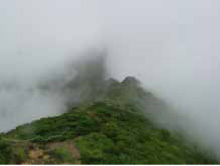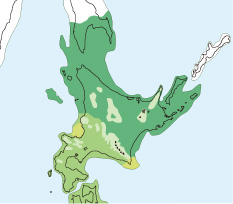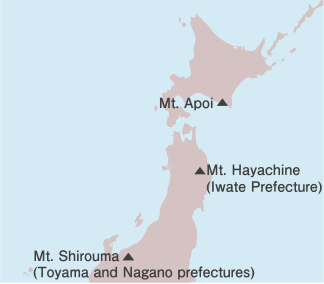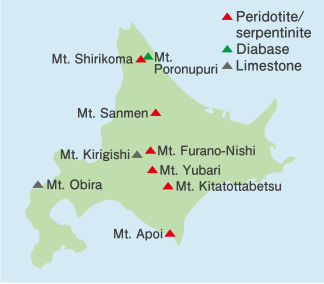1. Rare flora of Mt. Apoi nurtured by peridotite rock
- Theme B:
Learning about and enjoying the natural environment from Mt. Apoi's alpine plants
Mt. Apoi and its surroundings have an extraordinary ecosystem characterized by the coexistence of northern and temperate flora and fauna, making the area a biodiversity hotspot. In the region's mixed coniferous and broad-leaved forests, Kitagoyo (P. parviflora var. pentaphylla; a cool temperate-zone species) and alpestrine Glehn's spruce trees grow together. This region provides habitats for alpine plants and animals such as Japanese pikas at low altitudes, and also represents the eastern limit for numerous temperate-zone plants (e.g., Stephanandra incise and Quercus serrata). Notably, despite its low altitude of 810 meters, Mt. Apoi is home to approximately 80 species of alpine plants, including nearly 20 endemic species (including subspecies, varieties and forms ). Such a concentration of endemic species is seen in few other places worldwide.
The three factors outlined below (including peridotites as gifts from deep inside the earth) are considered to be behind the presence of such an extraordinary ecosystem.
Factor No. 1: Geology

Mt. Apoi's peridotite-derived soil has a high content of magnesium and nickel, which are known to hinder plant growth. As peridotite does not readily break down, it also takes time for soil to build, and once accumulated it is easily removed by wind and rain. As a result, the layer of soil covering Mt. Apoi is thin, has poor water retention properties and is low in nutrition. These conditions inhibit the growth of coniferous forests, which are a climax community, and allow the growth of alpine plants.
Factor No. 2: Climate

As winter snowfall in the Mt. Apoi area is limited, freeze-thaw action tends to affect soil in windswept parts. This leads to plant root damage, destabilization of soil on slopes and other issues. Due to its proximity to the sea, the mountain is also enveloped in sea fog, especially during the summer, resulting in lower temperatures. These meteorological conditions give the low-altitude Mt. Apoi a high-altitude mountain environment.
Factor No. 3: Geological history

As Mt. Apoi formed on land and was never under the sea, flora from the time of its creation remain today. Plants from northern regions that migrated southward to Japan during the glacial period when it was still connected to continental Asia found shelter on Mt. Apoi and other local mountains during the warm interglacial period. Plants that remained on or came to Mt. Apoi in this way have evolved while adapting to the special peridotite soil, and have become endemic species unique to the area.
Thanks to these conditions, alpine species found only on Mt. Apoi bloom despite the mountain's moderate altitude of 810 meters. In 1952, these alpine flora were collectively designated as a Special Natural Monument of Japan called the Mt. Apoi Alpine Plant Community.
- Mt. Apoi Alpine Plant Community - designated as a Special Natural Monument of Japan in 1952
- Other Special Natural Monuments of japan in Hokkaido ●Taisetsu Mountain Range ●Mt. Showa-Shinzan ●Nopporo Forest Park ●Japanese cranes ●Marimo algae balls in Lake Akan

Alpine plant communities designated as Special Natural Monuments of Japan (3)

Major mountains with special rock vegetation in Hokkaido



